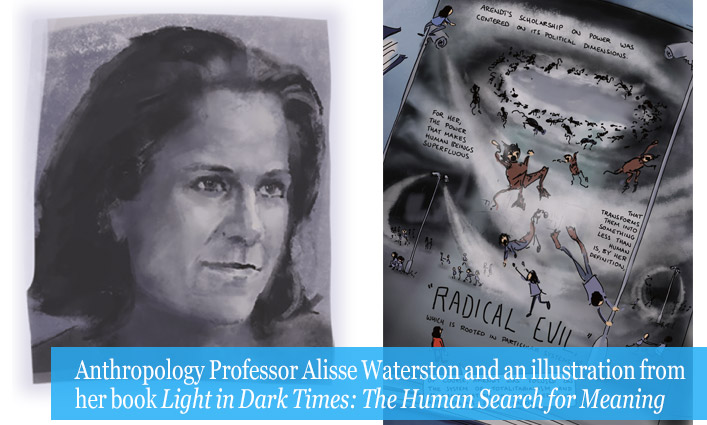
When Anthropology Professor Alisse Waterston, Ph.D., one of the founders of the Vera Fellows Program, was the President of the American Anthropological Association, she was tasked with the assignment of addressing her peers at the end of her tenure. “A thousand anthropologists were in the audience and I titled my talk ‘Four Stories: A Lament and An Affirmation,’” Waterston recalls. “The four stories reflected on being introspective; thinking in dark times; truth, lies and the danger of the trivial; and on envisioning an alternative world.” This lament explored her feelings, the feelings of others, and most importantly, it reaffirmed the value of knowledge.

“I explained that there was no doubt that we were living in dark times. But we had to ask ourselves, ‘How are we going to spend the time that is given to us on earth?’ I was calling on us to act.” — Alisse Waterston
To deepen the mood throughout the talk, Waterston had the audio-visual team purposely cast different hues and effects—from a darkened room with hazy, purplish lighting to crystal-clear brightness. “I explained that there was no doubt that we were living in dark times. But we had to ask ourselves, ‘How are we going to spend the time that is given to us on earth?’ I was calling on us to act.” The speech was a hit, touching the hearts and minds of everyone in the audience. She didn’t know it then, but that speech would be the blueprint for her graphic narrative Light in Dark Times: The Human Search for Meaning.
Envisioning a Book
After Waterston gave her speech, she hosted a breakfast and breathed a sigh of relief that her term as President was both successful and complete. “I was going to be finished and free,” Waterston says with a laugh. Then she received an email learning that in the audience, Charlotte Corden (née Hollands), a young British artist moved by Waterston's words, created a magnificent illustration of the talk. Waterston’s husband—who had heard her practice the speech numerous times—had already suggested turning it into a book, and connecting with Corden felt like kismet. “I reached out to her months later and asked her what she thought. She said yes and that’s when we got started. Neither of us knew how to make a graphic book, but since my kids were grown up, and she had a few months to travel, I suggested that she stay with me while we worked on it. It was an intense collaboration,” says Waterston.

“All throughout the book you see a strand of light, that’s the possibilities.” — Alisse Waterston
In the basement of Waterston’s house, the duo taped a huge roll of art paper against the wall. As Waterston started reciting her speech, Corden started drawing. At different times Corden would ask, “What do you mean by this word?” or “What are you trying to convey when you say this sentence?” She’d draw and pace, draw and pace as Waterston slowly moved through each sentence. “Charlotte was trying to translate my words into their visual representation,” Waterston remembers. Together they came up with the title. Waterston helped Corden accept the darkness of the world, and Corden helped Waterston appreciate the light. “All throughout the book you see a strand of light, that’s the possibilities,” says Waterston.
Understanding Hope
That visual path of light in the book isn’t about a hooky, fairytale “happily ever after” ending. Instead, Waterston invokes the words of the Czech poet and playwright, Vaclav Havel, to explain that hope and optimism are two different things. For Havel, and in turn Waterston, “hope is not the conviction that something will turn out well, but the certainty that something makes sense, regardless of how it turns out.” This conviction drives us to explore new ideas and to continually strive for better conditions—even when we feel despair. “Cultural anthropology is about coming to understand meaning. What meanings do people attach to things and to other people? What are the meanings attached to rituals or words? Anthropology is the study of humankind, and part of what we do in this book is to ask, ‘How do we want to be human?’” Waterston explains.

“Anthropology is the study of humankind, and part of what we do in this book is at one point say, ‘How do we want to be human?’” —Alisse Waterston
Taking the Reader on a Journey
Light in Dark Times follows both the writer (drawn with a red shirt) and the illustrator (drawn with a blue shirt) as they meet instrumental people who dared to tackle darkness. Writers like Virginia Woolf, philosophers like Hannah Arendt, and justice activists like Bryan Stevenson share with Waterston and Corden a perspective on how humanity can move forward through dark times. By reading the thought-provoking words of different philosophers, activists, and anthropologists, the reader is called to affirm knowledge, combat lies, and to envision an alternative, more enlightened world.
After the reader goes through the four stories, there is a “lament” because Waterston felt the reader needed to remember, stay grounded, and understand why we embark on a journey to make change. “Then we ask, ‘What is to be done? What actions can we take to effect positive social change that prioritizes human needs over rapacious interests?’ Bryan Stevenson gives us an answer when he urges us to ‘get proximate to human suffering.’ That’s what we do as anthropologists, we become participant observers.” In essence, the journey that Waterston and Corden go on as characters in the pages of the book is the process that they hope readers go on to create more enlightened worlds based on their own ideals.
Listen to Professor Alisse Waterston read from Light in Dark Times: The Human Search for Meaning.



